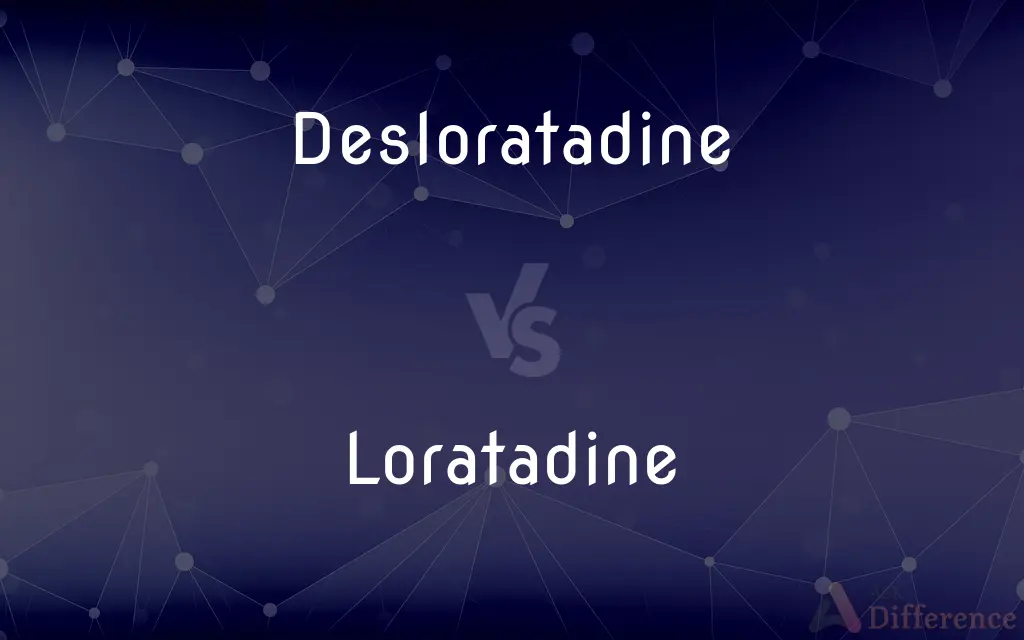Desloratadine vs. Loratadine — What's the Difference?
By Fiza Rafique & Urooj Arif — Updated on April 19, 2024
Desloratadine, derived from loratadine, is a potent second-generation antihistamine for treating allergies and hives. Loratadine, also a second-generation antihistamine, is less potent and may have sedative effects.

Difference Between Desloratadine and Loratadine
Table of Contents
ADVERTISEMENT
Key Differences
Desloratadine is the active metabolite of loratadine, meaning that it is the result of loratadine’s processing within the body. It is generally considered to be more potent and longer-acting. On the other hand, loratadine is the parent compound and is often sold under the brand name Claritin, known for its efficacy in treating symptoms of allergic rhinitis and urticaria without causing drowsiness.
While both medications are non-sedating antihistamines and do not cross the blood-brain barrier as readily as first-generation antihistamines, desloratadine has a higher affinity for histamine receptors and a longer duration of action, which can lead to enhanced effectiveness in controlling allergy symptoms. Conversely, loratadine might be less effective for some individuals and requires metabolism into desloratadine to reach its maximum efficacy.
Desloratadine is typically prescribed when a stronger or longer-lasting antihistamine effect is necessary, and it can also be used in slightly lower dosages to achieve similar or better effects than loratadine. Loratadine, however, is more widely available and often less expensive, making it a first-line option for many people suffering from allergies.
The choice between desloratadine and loratadine often depends on the patient’s response to treatment and the specific health profile, including how their body metabolizes the drug. For instance, individuals who do not adequately convert loratadine into its active metabolite might find desloratadine more effective.
Comparison Chart
Potency
Higher potency as an antihistamine
Less potent compared to desloratadine
ADVERTISEMENT
Metabolism
Active metabolite of loratadine
Metabolized in the liver to become active desloratadine
Duration of Action
Longer duration of action
Shorter duration of action compared to desloratadine
Sedative Effects
Minimal to no sedative effects
Slightly higher chance of sedation than desloratadine
Usage
Often used for more severe allergy symptoms
Commonly used for mild to moderate allergy symptoms
Compare with Definitions
Desloratadine
An antihistamine used to treat allergies and hives.
Desloratadine is often prescribed for chronic urticaria because of its long-lasting effects.
Loratadine
Commonly used to relieve allergy symptoms.
Loratadine helps him manage his seasonal allergies effectively.
Desloratadine
Effective in treating nasal and non-nasal symptoms of allergies.
She uses desloratadine to manage both her runny nose and itchy eyes.
Loratadine
Sold under the brand name Claritin and others.
Claritin, which contains loratadine, is available over the counter.
Desloratadine
Available under various brand names and generics.
You can find desloratadine in pharmacies as Aerius among other names.
Loratadine
Also treats symptoms of hives.
Loratadine has been effective in reducing the redness and itching of his hives.
Desloratadine
Known for minimal sedation.
Patients prefer desloratadine for daytime use as it does not cause drowsiness.
Loratadine
Suitable for daily use.
She takes loratadine daily during the spring to prevent allergy symptoms.
Desloratadine
Considered a second-generation antihistamine.
As a second-generation antihistamine, desloratadine offers relief without CNS effects.
Loratadine
Typically causes less drowsiness than first-generation antihistamines.
Loratadine is preferred over older antihistamines because it doesn’t make you sleepy.
Desloratadine
Desloratadine (trade name Clarinex and Aerius) is a tricyclic H1 antagonist that is used to treat allergies. It is an active metabolite of loratadine.
Loratadine
Loratadine, sold under the brand name Claritin among others, is a medication used to treat allergies. This includes allergic rhinitis (hay fever) and hives.
Desloratadine
(pharmaceutical drug) An active metabolite of loratadine, used to treat allergies.
Loratadine
A nonsedating antihistamine, C22H23ClN2O2, used to treat allergic rhinitis and other allergic disorders.
Loratadine
(pharmacology) An antihistamine drug used to treat allergies.
Common Curiosities
Can both desloratadine and loratadine be used for kids?
Yes, both are approved for use in children, but dosages will vary based on age and weight.
Are desloratadine and loratadine available over-the-counter?
Loratadine is available over-the-counter, while desloratadine usually requires a prescription.
What is the main difference between desloratadine and loratadine?
The main difference is that desloratadine is the active metabolite of loratadine, making it generally more potent and longer-lasting.
Which is better for avoiding drowsiness, desloratadine or loratadine?
Both are low-sedation antihistamines, but desloratadine is less likely to cause drowsiness compared to loratadine.
How quickly do desloratadine and loratadine work?
Both begin to work within 1 to 3 hours of ingestion, with effects lasting up to 24 hours.
Is one more effective for severe allergies?
Desloratadine may be more effective for severe allergies due to its increased potency.
Are there any major side effects associated with desloratadine or loratadine?
Both are generally well-tolerated, but side effects can include headache, fatigue, and dry mouth.
What should I do if I miss a dose of either medication?
If you miss a dose, take it as soon as you remember unless it's almost time for your next dose. Do not double up.
Can I switch from loratadine to desloratadine if my symptoms aren't controlled?
Yes, if loratadine does not effectively control your symptoms, your doctor may recommend switching to desloratadine.
Can these medications be taken with other allergy treatments?
Yes, they can be combined with other allergy treatments, but it’s best to do so under medical advice.
Share Your Discovery

Previous Comparison
Inscribe vs. Engrave
Next Comparison
Then vs. ThereforeAuthor Spotlight
Written by
Fiza RafiqueFiza Rafique is a skilled content writer at AskDifference.com, where she meticulously refines and enhances written pieces. Drawing from her vast editorial expertise, Fiza ensures clarity, accuracy, and precision in every article. Passionate about language, she continually seeks to elevate the quality of content for readers worldwide.
Co-written by
Urooj ArifUrooj is a skilled content writer at Ask Difference, known for her exceptional ability to simplify complex topics into engaging and informative content. With a passion for research and a flair for clear, concise writing, she consistently delivers articles that resonate with our diverse audience.
















































